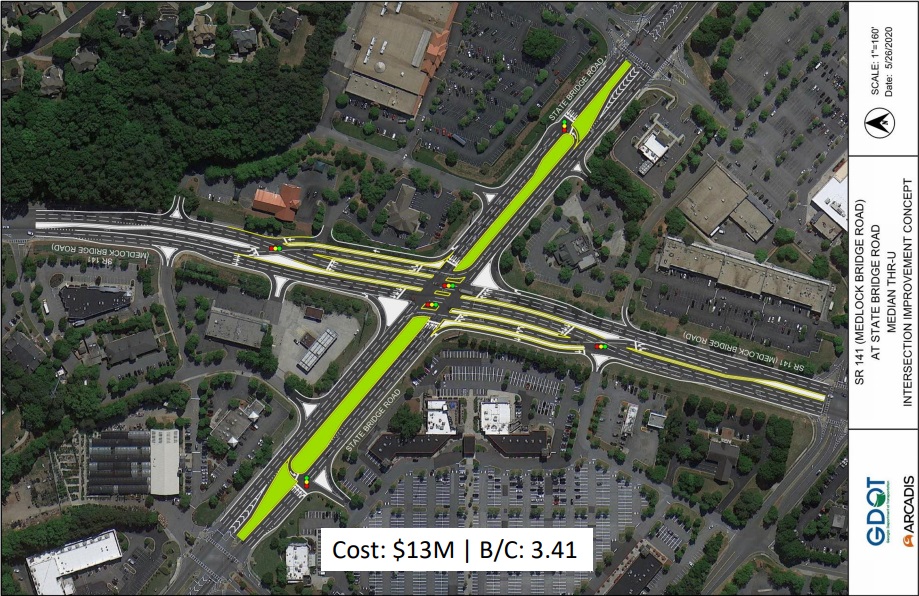In the midst of what is likely to be a permanent change in commuting habits, GDOT is proposing a long-term “solution” that combines two approaches that have seen previous resident resistance.
In a presentation of four potential options, GDOT lays out their case to reconfigure the intersection at Medlock Bridge Road/141 and State Bridge Road using a combination of a Continuous Flow Intersection (CFI), and the Michigan Thru-U (Thru-U) Intersection. The resulting design is sure to create confusion.

The graphic above indicates a cost of $13M. However, the Staff Report states that this option is expected to cost $16Million. TSPLOST funds allocated to this effort amount to $8Million and the Staff Report states that the “balance” of $5.17Million would be funded by GDOT. The discrepancy in numbers is not explained.
Many residents have been affected by changes in school and work patterns as a result of the COVID-19 virus. The number of people who will remain, home-based workers, is very likely to remain well above pre-COVID levels. As a result, traffic patterns have changed. The full adjustment to whatever becomes the “new normal” is yet to be understood.
An “interim improvement” to this intersection that was approved on August 24, 2020. The impact of that project was not factored into the analysis before GDOT met with Mayor Bodker and Councilman Coughlin on July 16, 2020. Councilman Coughlin did request an analysis of traffic to compare pre-COVID and more recent patterns. The results show that traffic volume has not returned to pre-COVID levels and that the number of vehicles traveling the roads is spread so that peak travel is below pre-COVID levels.
The complexity of the recommended intersection design is unique. The GDOT presentation includes one example of a Continuous Flow Intersection, but not in combination with a Thru-U design.
Is this where Johns Creek is to “Be the Exception”? The proposed design is overly complicated, never proven effective in Georgia, and maybe attempting to address a problem that has changed.

The cart is before the horse. More time should be taken to understand the long-term changes in traffic patterns and the impact of the interim solution before committing to a long-term solution that will negatively impact the suburban residential character of the community.
Source: Preserve Johns Creek
Information on the Michigan U Turn: https://www.clickondetroit.com/all-about-michigan/2019/10/15/how-the-michigan-left-turn-became-a-thing/
Information on CTI: https://www.wfmynews2.com/article/news/local/charlotte-gets-continuous-flow-intersection-nc16-mount-holly-huntersville-road-ncdot/83-77ebe14c-2dc1-453c-89fe-ab3d3cb38a97
There isn't much in this article to help form an educated opinion. To address some of the points in this article:
> The resulting design is sure to create confusion.
Any new traffic pattern is going to create confusion. People can learn and we shouldn't avoid innovation and change because it is different. The diamond intersections at Jimmy Carter and Ashford Dunwoody, roundabouts, and flashing yellow lights are other examples of change that has alleviated traffic with minimal confusion.
> The proposed design is overly complicated,
I understand that the driver needs to be aware of how to navigate the intersection but with clear signage and signaling this should not be an issue. Click on Detroit's website claims the Michigan U has 20-50% greater capacity for left turns and it is safer. North Carolina Department of Transportation (NCDOT) claims greater efficiency from CTI too.
> never proven effective in Georgia
These designs are effective elsewhere in the country and deductive reasoning tells us it should work about the same. There is nothing unique about the way we drive in Georgia.
> maybe attempting to address a problem that has changed.
I don't believe roads should be built for COVID-19 commute patterns. These roads will be around for much longer than this current pandemic.
> negatively impact the suburban residential character of the community.
This sounds again like a fear of change. For anyone that has sat on 141 waiting to turn left onto State Bridge at rush hour knows, about anything would be better whether it is the Michigan U, CTI or something else. I don't know how a traffic pattern has any effect on the character of a community?
Please spend more time explaining the facts and let the readers form their own conclusions.